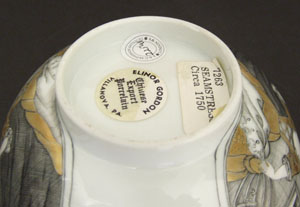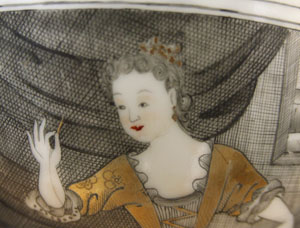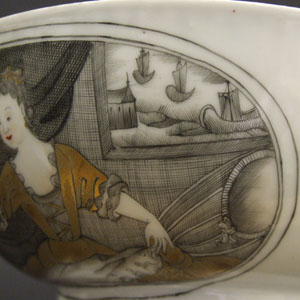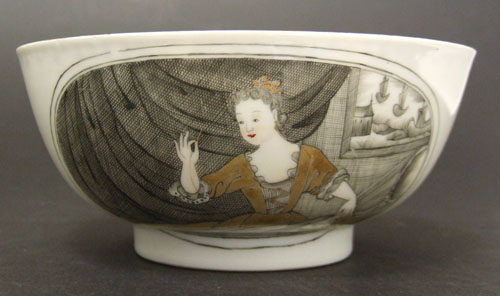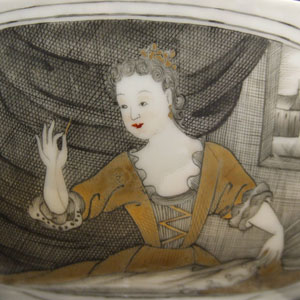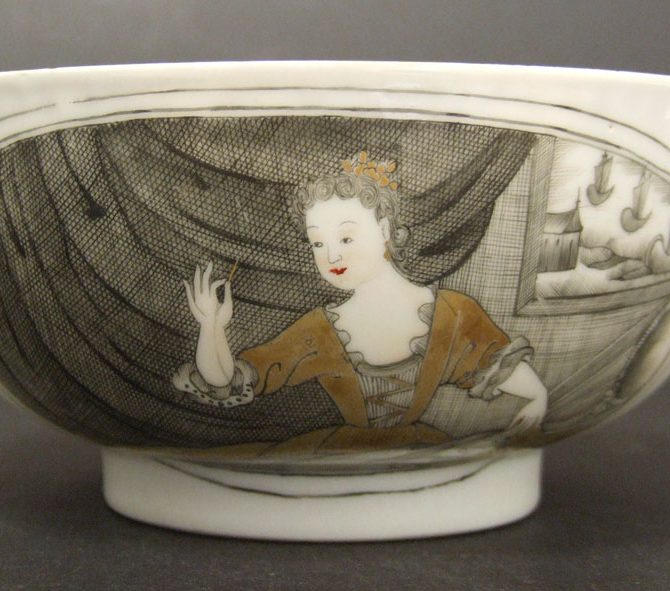
QIANLONG 1736 – 1795 Chinese Export Porcelain
An 18th Century Chinese Export Porcelain Bowl, Qianlong Period c.1750 – 1760. Finely Painted in Strong En Grisaille with Bright Gilding with a Design After a European Engraving Referred to as `The Seamstress` or `The Embroideress`. A Well Dressed Woman is Shown Sewing at a Window with Boats in the Distance, She is Sheltered by a Large Swath of Gathered Curtain Material Behind Her.
SOLD
- Condition
- Perfect with the strong dark en grisaille and gilding in excellent un-rubbed condition.
- Size
- Diameter : 14.1 cm (5 1/2 inches).
- Provenance
- The Elinor Gordon Collection of Chinese Export Porcelain, a typed label on the base "7263 Seamstress circa 1750" and a printed label "Elinor Gordon, Villanova, PA. Chinese Export Porcelain".
- Stock number
- 22541
- References
- For a Chinese porcelain plate with this design see : Chinese Export Porcelain, Elvehjem Museum of Art (Catherine Coleman Brawer, Elvehjem Museum of Art, University of Wisconsin-Madison,1992. ISBN 932900-30-5) page 114, plate 87. For another plate of this pattern see : Ceramics Crossed Overseas, Jingdezhen, Imari and Delft from the Collection of the Groninger Museum (Christiaan J.A. Jorg and others, Groninger Museum 1999) plate 109. For further plate with `The Seamstress` pattern see : Chinese Export Porcelain in the Reeves Center Collection at Washington and Lee University (Thomas V. Litzenburg Jr. Third Millennium Publishing London 2003. ISBN 1-903942-19-5) page 164, plate 159. Published : This en grisaille bowl, dated to c.1760, is illustrated in : Collecting Chinese Export Porcelain (Elinor Gordon, John Murray Publishing, 1978. ISBN 0-7195-3460-7) page 77, plate 61
Information
The `Seamstress` or `The Embroideress` Design :
This well known mid-18th century Chinese Export porcelain design is normally executed in En Grisaille . The Chinese painter imitates the engravers technique of black cross-hatched lines but to enliven the design for the medium of porcelain gilding is added, some examples also use a flesh tone. The original copper-plate engraving has yet to be identified, however Catherine Coleman Brawer in `Chinese Export Porcelain, Elvehjem Museum of Art` (Catherine Coleman Brawer, Elvehjem Museum of Art, University of Wisconsin-Madison,1992. ISBN 932900-30-5. Page 114, plate 87) says this ..."Dutch composition, which also appears on a Delft plate, is possibly after an engraving by Bernard Picart (1673-1733) a French artist who worked in Amsterdam".
